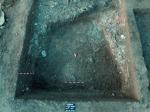Summary (English)
EXPLORATIONS NEAR THE VILLAGE OF KNYAZHEVO (Daniela Agre – daniela.agre@abv.bg, Deyan Dichev) In Sector West, a sector of the second fortification wall to the west of the bastion was excavated in Trench А’10; it was 1.10 – 1.15 m wide, built of roughly-cut stones. Fragmentary roof tiles, sherds, including from Greek amphorae, and pieces of iron slag were found to the east of the wall. In Trench A10, Structure I dug into the bedrock was explored, containing pieces of charcoal, animal bones, pieces of iron slag, a bronze arrowhead, fragmentary imbrices of the Laconian and the Corinthian Types, sherds from a dolium, Greek amphorae and black-gloss pottery (kantharoi, small bowls, etc.). Structure II dug into the bedrock was explored, containing fragmentary building ceramics and sherds from amphorae. In Trenches D5 and E5-6, sherds from tableware and Greek black-gloss pottery were found to the north of the northern fortification wall. A sector of the fortification wall was excavated in Trench E6. In the Central Sector, a metallurgical furnace was discovered in Trench I8, to the west of the wall surrounding the central residential building. Fragmentary building ceramics, sherds from Greek amphorae and six bronze coins were found. In Sector North, the explorations of two sunken-floored buildings were completed in Trenches K2, L/M–1/2, to the north of the central residential building. The buildings were c. 4.50 m long and 2.50 – 3 m wide, related to metallurgical activities and dated to the second occupation period. In Trench O2, four ritual pits were discovered, containing fragmentary building ceramics, sherds and animal bones. The exploration of the eastern ditch continued; it contained sherds, mostly from Greek amphorae, fragmentary building ceramics, pieces of slag and charcoal. Three stamped handles of Greek amphorae, a bronze coin and sherds from Greek black-gloss pottery were also found there. The ditch surrounded the fortification wall. In Sector East, a metallurgical furnace was excavated in Trenches R4 – R5 and a large quantity of slag, fragmentary building ceramics and sherds were found. The chronology of the site is: First Period (c. 340 – 275 BC) related to the existence of the Thracian royal tyrsis and its burning at the end of the period; Second Period (c. 275 – 250 BC) related to iron metallurgy; Third Period (c. 250 – 200 BC) related to building a tumulus over the debris of the central residential building and performing ritual activities.
- Daniela Agre - Archaeological Institute with Museum
- Deyan Dichev - Archaeological Institute with Museum
Director
- Daniela Agre - Archaeological Institute with Museum
- Deyan Dichev - Archaeological Institute with Museum
Team
Research Body
- Archaeological Institute with Museum






![Download [PDF]](/excavation/skins/fasti/images/results/download_sml.png)
